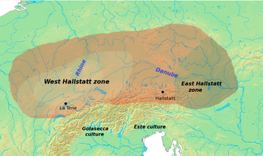
Back حضارة غولاساكا Arabic Golasecca-Kultur German Πολιτισμός της Γκολαζέκα Greek Cultura de Golasecca Spanish Culture de Golasecca French Cultura de Golasecca Galician Cultura di Golasecca Italian 골라세카 문화 Korean Golasekos kultūra Lithuanian Cultura Golasecca Romanian
| Geographical range | North Italy |
|---|---|
| Period | Bronze Age, Iron Age |
| Dates | c. 9th century BC - 350 BC |
| Preceded by | Canegrate culture, Urnfield culture |
| Followed by | Roman Republic |

The Golasecca culture (9th - 4th century BC) was a Late Bronze Age/Early Iron Age culture in northern Italy, whose type-site was excavated at Golasecca in the province of Varese, Lombardy, where, in the area of Monsorino at the beginning of the 19th century, Abbot Giovanni Battista Giani made the first findings of about fifty graves with pottery and metal objects.
The culture's material evidence is scattered over a wide area of 20,000 km²[1] south of the Alps, between the rivers Po, Serio and Sesia, and bordered on the north by the Alpine passes.
- ^ Raffaele de Marinis, Liguri e Celto-Liguri in Italia. Omniun terrarum alumna, Garzanti-Scheiwiller, 1988.